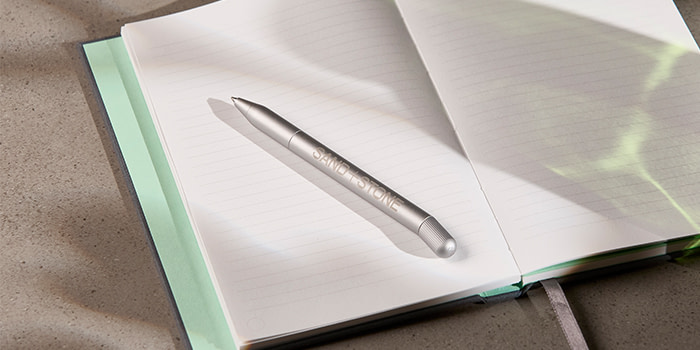From concept to design: why it pays to go offline
We chat with our Lead Product Designer about the joys of logging off.

We’ve created some pretty iconic products over the years. But products like the MOO Twist Pen and Hardcover Notebook don’t just appear overnight. Behind every bestseller there are thousands (and thousands…) of hours spent designing, creating and iterating.
And you might be surprised just how much of that process happens not on expensive computers, but on good old-fashioned paper.
Designing the MOO Twist Pen

Felix is MOO’s Lead Product Designer, and he’s the man behind some of our most popular products. Like most product designers, he carries a MacBook around the office. But he’s also keen to stress just how important pen and paper is for the creative process.
“Everything starts with an idea. That idea can be something that pops into your head, something you see out and about, or something you’re told,” says Felix. “The idea is the free bit. What’s not free is developing your idea, taking small, iterative steps to improve your design. I always start by grabbing a pen and sketching.”
“I always start by grabbing a pen and sketching.”
With the Twist Pen, the team knew they didn’t need to reinvent anything. Pens have been doing a pretty great job for the last 5,000 years, so a ground-up rethink wasn’t necessary. What Felix did know was that he wanted to create something differentiated and recognizable. Something distinctly MOO. “When you see the Twist Pen, unbranded, it’s clearly a MOO product. But as soon as it’s branded, it becomes that company’s product.”

“We decided fairly quickly to combine existing functional components with high-quality, sustainable materials, and to package it in an identifiable silhouette,” Felix explained. “It was important to make the pen refillable, too. This is a tool that’ll last a long time. It can sit on your desk, be used every day, and refilled with any G2 Parker Style cartridge you like – it doesn’t have to be the Schmidt refill it comes with.”
Thinking with your hands

During the early stages of creating, pen and paper are essential tools. They connect you with your ideas in a very real, tactile way, unlike apps that are often cluttered and filled with restrictive templates and tools.
“Using digital tools is great for quick changes, and working iteratively,” Felix said “But the beauty of pen and paper is that it gives you freedom to explore ideas without the limits of a screen; without being limited by a particular app or piece of software. Analog sketching feels more free.”
Bringing the Pen to life

The first thing you’ll notice when you pick up a MOO Twist Pen is the weight. It’s made from recyclable aluminum, which gives it a lovely premium feel, and makes writing a joy. During the design process, no amount of iPad sketches can let you know how the final product will feel when a customer holds it. So for Felix, this means getting hands-on as soon as possible.
“Once I’ve made my initial pen-and-paper sketches, I try to make something physical. With the Twist Pen, that meant going to the hardware store to get some dowels of wood, to test how various diameters felt in the hand.”
Why analog still matters

Analog creation has never been more important. It taps into a freer, more creative way of thinking that can set you apart from competitors, and make your work more fun and fulfilling.
In a world filled with phone notifications, email pop-ups and mindless scrolling, sometimes it pays to go offline. You could even end up with an amazing product like the MOO Twist Pen.
Discover a whole range of analog tools to help bring your ideas to life.
Keep in touch
Get design inspiration, business tips and special offers straight to your inbox with our MOOsletter, out every two weeks.



